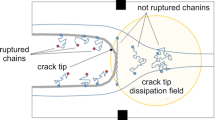Abstract
Flaw-resistance, KR-curve, thermal shock, and stress-strain behavior of a wide range of different ceramic composites are investigated. The experimental results seem to reveal that there is an interrelation between all four properties. However, more critical considerations show that, despite common trends for the majority of the materials, some materials do not obey this interrelation. Probable reasons for their behavior are discussed.
Access this chapter
Tax calculation will be finalised at checkout
Purchases are for personal use only
Preview
Unable to display preview. Download preview PDF.
Similar content being viewed by others
References
Lutz, E.H. and Swain, M.V. (1991) ‘Interrelation between Flaw Resistance,, R-Curve Behavior, and Thermal Shock Strength Degradation in Ceramics’, J. Am. Ceram. Soc. 74 (11), 2859–68.
Lutz, E.H. and Swain, M.V. (1992) ‘Interrelation between Flaw Resistance, KR-Curve Behavior, and Thermal Shock Strength Degradation in Ceramics’, in R.C. Bradt et al. (eds.), Fracture Mechanics of Ceramics, Vol. 10, Plenum Press, New York, pp. 319–37.
Lutz, E.H. and Swain, M.V. (1992) ‘Stress-Strain Behavior of Duplex Ceramics: I-Observations’, J. Am. Ceram. Soc. 75 (7), 1729–36.
Lutz, E.H. and Swain, M.V. (1992) ‘Stress-Strain Behavior of Alumina, MagnesiaPartially-Stabilized Zirconia, and Duplex Ceramics and Its Relevance for Flaw Resistance, KR-Curve Behavior, and Thermal Shock Behavior’, appears in: J. Am. Ceram. Soc. 75 (10).
Lutz, E.H. and Swain, M.V. (1992) ‘Fracture Toughness and Thermal Shock Behavior of Silicon Nitride - Boron Nitride Ceramics’, J. Am. Ceram. Soc. 75 (1), 67–70.
Cook, R.F., Lawn, B.R., and Fairbanks, C.J. (1985) ‘Microstructure-Strength Properties in Ceramics: I, Effect of Crack Size on Toughness’, J. Am. Ceram. Soc. 68, 604–15.
Chantikul, P., Bennison, S.J., and Lawn, B.R. (1990) ‘Role of Grain Size in the Strength and R-Curve Properties of Alumina’, J. Am. Ceram. Soc. 73 (8), 2419–27.
Cook, R.F. and Clarke, D.R. (1988) ‘Fracture Stability, R-Curves, and Strength Variability’, Acta Met. 36 (3), 555–62.
Krause, R.F. (1988) ‘Rising Fracture Toughness from the Bending Strength of Indented Alumina Beams’, J. Am. Ceram. Soc. 71 (5), 338–42.
Hasselman, D.P.H. (1969) ‘Unified Theory of Fracture Initiation and Propagation in Brittle Ceramics’, J. Am. Ceram. Soc. 52 (11), 600–604.
Homeny, J. and Bradt, R.C. (1980) ‘Thermal Shock of Refractories’, in D.P.H. Hasselman and R.A. Heller (eds.), Thermal Stresses in Severe Environments, Vol. 6, Plenum Press, New York, pp. 343–63.
Swain, M.V. (1983) ‘R-Curve Behavior of Magnesia-Partially-Stabilized Zirconia and Its Significance for Thermal Shock’, in R.C. Bradt et al. (eds.), Fracture Mechanics of Ceramics, Vol. 6, Plenum Press, New York, pp. 345–59.
Lutz, E.H., Swain, M.V., and Claussen, N. (1991) ‘Thermal Shock Behavior of Duplex Ceramics’, J. Am. Ceram. Soc. 74 (1) 19–24.
Chen, I.-W. and Reyes-Morel, P.E. (1986) ‘Transformation Plasticity and Transformation Toughening in Mg-PSZ and Ce-TZP’, in P.F. Becher et al. (eds.), Materials Research Society Symposia Proceedings, Vol. 78, Advanced Structural Ceramics, Materials Research Society, Pittsburgh, PA, pp. 75–88.
Heuer, A.H., Lange, F.F., Swain, M.V., and Evans, A.G. (1986) ‘Transformation Toughening: An Overview’, J. Am. Ceram. Soc. 69 (3), i–iv.
Evans, A.G. and Faber, K.T. (1984) ‘Crack Growth Resistance of Microcracking Brittle Materials’, J. Am. Ceram. Soc. 67 (4), 255–60.
Swain, M.V. (1990) ‘R-Curve Behavior and Thermal Shock Resistance of Ceramics’, J. Am. Ceram. Soc. 73 (3), 621–28.
Gogotsi, G.A. (1977) ‘The Problem of the Classification of Low-Deformation Materials Based on the Features of their Behavior under Load’, Strength Mater. ( Engl. Transl. ) 9, 77–83.
Chantikul, P., Anstis, G.R., Lawn, B.R., and Marshall, D.B. (1981) ‘A Critical Evaluation of Indentation Techniques for Measuring Fracture Toughness: II, Strength Method’, J. Am. Ceram. Soc. 64 (9), 539–43.
Marshall, D.B. and Lawn, B.R. (1979) ‘Residual Stress Effects In Sharp Contact Cracking’, J. Mat. Sci. 14, 2001–12.
Author information
Authors and Affiliations
Editor information
Editors and Affiliations
Rights and permissions
Copyright information
© 1993 Springer Science+Business Media Dordrecht
About this chapter
Cite this chapter
Lutz, E.H. (1993). Interrelation between Flaw Resistance, R-Curve Behavior, Thermal Shock Strength Degradation, and Stress-Strain Behavior of Ceramics. In: Schneider, G.A., Petzow, G. (eds) Thermal Shock and Thermal Fatigue Behavior of Advanced Ceramics. NATO ASI Series, vol 241. Springer, Dordrecht. https://doi.org/10.1007/978-94-015-8200-1_7
Download citation
DOI: https://doi.org/10.1007/978-94-015-8200-1_7
Publisher Name: Springer, Dordrecht
Print ISBN: 978-90-481-4291-0
Online ISBN: 978-94-015-8200-1
eBook Packages: Springer Book Archive




